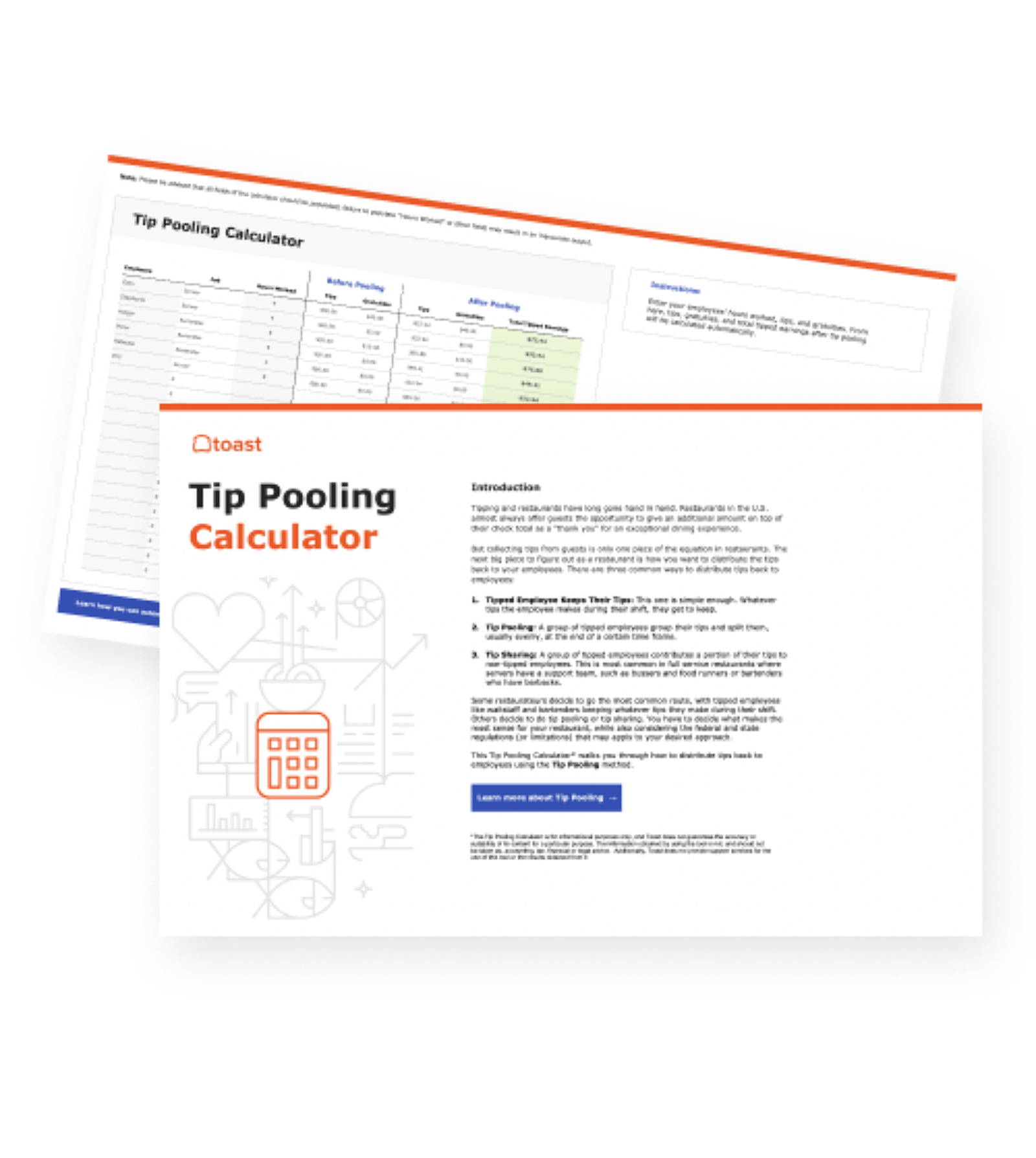
How to Survive the Restaurant Industry Labor Shortage
Dive into the data to see how to help boost employee retention for your restaurant operation — even amidst the ongoing labor shortage.

Justin GuinnAuthor


Tip Pooling Calculator
Use the Tip Pooling Calculator to learn how to distribute tips back to your restaurant’s employees using the tip pooling method.
Great food and service are at the core of successful restaurants. Each requires skilled employees in the front and back of house — skilled workers that are hard to find and can be even harder to retain in the ongoing restaurant labor shortage.
Record employee churn within the restaurant industry is impacting this staffing shortage as much as anything else.
New data from Toast highlights tactics that may help operators combat churn and place a greater emphasis on restaurant employee retention.
Toast is the point of sale system built for restaurants. We conducted an online blinded survey between February 27, 2023 - March 19, 2023 of 1,011 current restaurant employees.
In this article, we showcase employee-focused insights and how operators can help boost employee retention and survive the restaurant industry labor shortage. You’ll also learn systems and tactics that can help with hiring and further encourage greater retention.
Key findings on how to survive restaurant industry labor shortage
- Restaurant industry's annual turnover rate is on track for the lowest annual rate since 2017 at 73.9%
- Most restaurant employees (46%) are motivated by making money and supporting their lifestyle — while 18% of restaurant employees are motivated by career development and growth within the restaurant industry
- Churn remains a problem, as 30% of staff are at risk of leaving the industry in the next 2 years
- Restaurant staff that churn cite poor hourly pay (47%), not being recognized for hard work (44%), and bad managers (37%) as their top pain points
Two weeks or more of training is the sweet spot for successful staff sentiment — though nearly three-quarters of restaurant staff (74%) receive two weeks or less of training and onboarding
Restaurant New Hire Onboarding Checklist
Bringing new employees onto your team can be both exciting and challenging. Use this free PDF checklist to set your staff up for success.

Current state of the restaurant staffing shortage and employee turnover
There are definitely layers to unpack with the restaurant industry labor shortage.
According to the National Restaurant Association, there are currently 15.6 million people in the food service workforce, just 0.4% below the pre-COVID peak. Quit rates are back down to relatively normal levels at 4.8% per month, and unemployment is way down, with an average of just 0.7 unemployed people for every job opening.
Restaurant turnover is the calculation of how many restaurant employees leave their job over a given time period. Turnover rate can also be known as the restaurant employee churn rate.
Using the most recent data as of January 2024, the average annual restaurant industry turnover rate is 79.6% over the past 10 years.
Prior to the pandemic, the average restaurant industry turnover rate was 71.6% (from 2013-2019). The data shows that the 2020 annual rate of 132% was heavily influenced by the lockdowns and subsequent restaurant closings in March and April of that year (36.5% and 28.7% respectively.)
Since then, the restaurant industry turnover rate has remained higher than pre-pandemic — though it’s on track for the lowest annual rate since 2017 at 73.9% (using 10 years of historic averages to forecast unreleased data from 2023.)
Lower industry turnover can be great for helping you survive the restaurant industry labor shortage — if you're close to being fully staffed. If you're struggling to discover and hire new talent, then less restaurant employees switching jobs may mean fewer candidates for your talent pool.
These trends are highlighted in research from 7Shifts that found restaurant hiring, increasing retention, and controlling labor costs are top restaurant operator challenges.
Understanding and reducing turnover rates to ease the restaurant labor shortage
Restaurant turnover is inevitable. Not all employees will work out for your restaurant or for the industry — and that's OK. With that in mind, there are two types of employee turnover that each compound the labor shortage:
- Staff members exiting the restaurant industry
- Staff members taking a job at another restaurant
Our research identified four categories of restaurant workers based on how long they plan to work in the industry. The data shows that 30% of restaurant workers plan to leave the industry in less than two years — fitting into this first turnover bucket.
The following insights focus on those employees who are churning while remaining in the industry — or leaving your restaurant to work at another.
Overcoming churn for restaurant staff team members switching jobs
For restaurant staff looking to stay in the industry for more than two years, a majority of them are “Somewhat or Very Interested” in finding a new restaurant job — or churning.
Nearly half (45%) of team members left a prior restaurant job for another due to dealing with a bad manager. That’s followed by low pay, lack of recognition, and work schedule complaints.
While pay is one thing, bad managers have a greater impact on churn longer-term restaurant employees
Many restaurants are prioritizing managers in their restaurant hiring and retention strategies — and rightfully so. It’s critical that restaurants attract and retain talented managers that vibe with the rest of the staff.
Our research shows 45% of medium- to long-term restaurant employees surveyed left a job because they didn’t have a good relationship with their manager — compared to 42% leaving for inadequate pay.
Ideally, a good manager can cut through and at least create a tolerable working relationship with all restaurant staff. Once restaurants find a great manager, the priority must switch to retaining them.
For pay, it's certainly not always easy to determine how much restaurants should pay their employees. Operators and managers must offer competitive wages that attract skilled, reliable job candidates, even though rising food costs may be hurting the margins used to supply that wage.
Minimum wage hikes continue to be a big driver and topic when it comes to restaurant wages. As of January 1, 2023, 23 states and Washington D.C. increased their minimum wage.
Applying behavioral research to better understand employees and survive the labor shortage
Restaurant business owners, operators, and especially managers may find value in studying common personas that articulate employee motivations and ambitions.
Toast’s research classifies into four buckets based on their needs and desires within the industry.
Here’s the breakdown of these four personas and what motivates them:
Most restaurant employees (46%) are motivated by making money and supporting their lifestyle.
The second most common persona (22%) is motivated by saving money to achieve a future goal unrelated to the restaurant industry, such as paying for school or a new car.
There’s a sizable portion (18%) that are motivated by developing skills and sustaining a long-term career in the restaurant industry.
The final persona (14%) is motivated simply by keeping busy and making some extra cash to support lifestyle activities.
Using personas to customize your approach to onboarding, training, and general staff management can help improve these practices by aligning with specific employee motivations and behaviors.
Along with these personas, Toast research also uncovered what most motivated restaurant employees to join their latest restaurant job.
A majority (56%) of employees said they accepted their most recent restaurant job because of the flexible schedule. Along with schedule flexibility, convenient commute (42%), good hourly pay (42%), and free meals (26%) were other top reasons.
Training Manual Template
Use this restaurant training manual template, a customizable Word Doc, to provide your staff with the rules, guidelines, and clarity they need to do their jobs efficiently.

Optimized training can help encourage retention and labor shortage survival
Employee training is essential in the restaurant industry, but many restaurant professionals still haven’t cracked the code on the best way to engage their teams to learn new skills. Is it best to throw new cooks into the fire — literally — on their first day in the kitchen, or to send them home with videos to watch and homework to do?
Hiring managers need to have a plan in place for training. Toast’s research found onboarding and training across the industry can be incredibly sporadic — making thoughtful, organized onboarding a potentially endearing benefit.
Almost 75% of restaurant employees spend less than two weeks training when they first start — though QSR employees are given slightly more time.
Toast’s data shows restaurant staff perception of their training broken down by the extent of it. Turns out that restaurant staff who trained for longer periods of time have more positive perceptions of their training.
Over 80% of restaurant staff that got at least three weeks of training listed their training as good or very good. That’s compared to 45% for staff that got less than a week of training — and 69% that got one to two weeks of training.
These first few weeks of onboarding and training can be crucial for setting the tone and showing off your restaurant mission and team in action. Hiring managers can start with introductions across the team.
A buddy system can be a great way to usher new team members through their onboarding period — or champions across each team can help as a point of contact for the rest of their crew.
Great restaurant managers can round out their onboarding by setting up times to sit down with new staff over the first few months. This can be a great way to keep track of how they’re doing and feeling in the new role.
Restaurant tech and strategies that boost efficiency, can help limit negative impacts of the worker shortage
The reality is that the restaurant labor force is growing but still well off pre-pandemic levels — and there’s no secret trove of labor somewhere to help ease the issue.
The negative impacts have become increasingly apparent for those restaurants that can control their churn.
Here are some ways the current restaurant industry worker shortage is affecting operations and how the right restaurant tech could help you overcome them.
Restaurant labor shortages can lead to longer wait times — which proper tech can help mitigate
Fewer staff members in the front of house can require servers to take on larger sections, increase line sizes, and add to wait times.
Fewer back-of-house staff available can prolong prep times, slow down table turns, and limit overall fulfillment capacity for on- and off-premise orders.
Restaurants can help eliminate wait times and empower staff members by adopting a new, tech-enabled service model. Toast’s New Steps of Service helps boost front-of-house efficiency, cut lines and reduce wait times, and give guests the power to order and pay as they please.
With the New Steps of Service, guests can order food and drinks whenever they’re craving them, not having to wait for a server to come over before ordering another round.
Popmenu found that 71% of diners say restaurant technology online and on-premises improve their restaurant experiences. And a 2021 report from Deloitte found that 64% of customers prefer to order digitally on-premises at a quick-service restaurant, with 57% of customers prefer to use a digital app to order food for off-premises dining.
Menu Engineering Course
Take this course to make the most of your menu. Learn about menu psychology and design, managing your menu online, and adapting your menu to increase sales.

Menu optimization and cost control mechanisms can help mitigate staffing and hiring crisis margins
Fewer staff members and a slower pace of business could decrease the number of checks you do in a night — leaving you with a falling cash flow that can substantially affect your operational hours, purchasing decisions, and more.
The average restaurant profit margin falls somewhere between 3 to 5 percent. The labor shortage may shrink labor costs due to working short-handed and paying fewer staff. On the flip side, you will have to keep a close eye on any overtime pay. And sustained worker shortages over time may lead to fewer hours open each week.
We’re already seeing this in the NRA data, as 48% of restaurants have trimmed hours on days when they are open and 32% are now closing on days they were formerly open.
If hiring more folks isn’t an option in the short term, operators can try optimizing their menus and taking control of food costs as a means to carve out margin to offset labor increases and lost revenue.
Menu engineering can help ensure operators are getting the most from each ticket, customer, and menu item. It can be an effective and scalable practice that helps to balance menus between popularity and profitability. The end goal is to strike a harmony between costing and pricing information with your restaurant vibes and brand.
Controlling food cost starts with recording and analyzing ingredient pricing data — and that starts with invoice automation. Restaurant operators can equip their back-of-house staff to all digitize invoices with the simple snap of a photo. From there, the data can be categorized, attributed to recipe and plate costs, and passed through to accounting systems to keep your general ledger updated.
Restaurant Cost Control Guide
Use this guide to learn more about your restaurant costs, how to track them, and steps you can take to help maximize your profitability.

Adopt transparency into your management and compensation models
From gratuity-free and restaurant co-ops to open-book management and profit-sharing, there are several non-traditional employment models available to restaurateurs who are finding their existing staff management model isn’t attractive for potential employees.
Open-book management, for example, is popular among restaurateurs and staff because it engenders a culture of ownership and empowers your employees by showing them exactly how the restaurant is doing and how their work impacts results.
But does it work? Henry Patterson, CEO, and founder of ReThink Restaurants, trains restaurants in implementing open-book management and profit-sharing model through hands-on, financial literacy training. While the average restaurant profit margin falls around 5%, ReThink Restaurants considers 10% basic health, with the majority of their clients hovering somewhere in the mid-20's. A business model that increases profitability, employee retention, and workplace satisfaction? Sign me up.
Take a hard look at your restaurant employee benefits and ask yourself: Are these benefits enough to make my restaurant a top choice for prospective employees?
According to research from Provi and SevenFifty Daily, when asked which workplace policies are important, 73 percent of those surveyed pointed to paid time off (PTO), including sick leave and vacation time, while 68 percent cited healthcare benefits as important.
Though it might seem like just another operational expense, employee benefits are worth their weight in gold for the substantial impact they have on employee retention and recruitment. With the cost of replacing one hourly restaurant employee running around $2,000, finding room in the budget for benefits seems like a no-brainer.
Health insurance, profit-sharing, on-the-job hospitality skills training, the flexibility to pick up on-call shifts, year-end bonuses, and free-shift meals are just a few ideas worth considering. If you’re unsure about whether an employee benefits package is worth the investment or if potential and existing staff will think it meaningful, try out a performance-based incentive first.
When restaurant employees feel supported by their employer through great pay and benefits, they’re happier and can do their best work.
Reconfigure your hiring practices and look for new amplification tactics
Because we’re in the middle of a restaurant staffing shortage, you can’t just rely on your usual hiring tactics to attract new talent.
Here are some outside-the-box hiring tactics to consider:
- Reach out to your community. If you have friends with working age kids, see if they’re looking for part-time work or a summer job.
- Create an employee referral program that motivates your staff with rewards for successfully referring their friends, family, and greater networks to open staff positions. You could also consider opening this to the public: Put a small print out in checkbooks, on tables, and in takeout orders offering a reward – like a free meal – for any referred candidates you successfully hire.
- Host a hospitality networking night where you invite front- and back-of-house staff from restaurants in the area to meet. By tying your brand to an event centered around community building and career growth opportunities, you’re bound to get a resume or two.
- From hospitality job boards to ads on social media, cast a wide net to ensure you’re getting a larger pool of candidates to choose from. Many job sites and social media sites allow you to target your ads to people within a certain geographical area; this could help you get in front of job seekers who would have manageable commutes to your restaurant.
Labor Shortage? You got this.
A labor shortage isn't easy for any business owner or operator to fight — especially in an industry like ours. Recruiting and retaining quality employees is tough to do, but not impossible.
The key is making your team feel valued, compensated well, and well taken care of, and with some time, attention, and the above tips in your back pocket, your restaurant will continue to get through it and prepare for the future.
This information is provided for general informational purposes only. Toast does not warrant the completeness of any information, text, graphics, links, or other items contained within this content. Toast does not guarantee you will achieve any specific results if you follow any advice herein. It may be advisable for you to consult with a professional such as a lawyer, accountant, or business advisor for advice specific to your situation.
Methodology
Toast conducted a blind online survey of 1,011 U.S. restaurant employees not operating at a manager or owner level ages 18 and older between February 27 - March 19, 2023. Respondents were not made aware that Toast was fielding the study. Using a standard margin of error calculation, at a confidence interval of 95%, the margin of error on average is +/- 3%.
Related Resources
Is this article helpful?
DISCLAIMER: This information is provided for general informational purposes only, and publication does not constitute an endorsement. Toast does not warrant the accuracy or completeness of any information, text, graphics, links, or other items contained within this content. Toast does not guarantee you will achieve any specific results if you follow any advice herein. It may be advisable for you to consult with a professional such as a lawyer, accountant, or business advisor for advice specific to your situation.
Read More
Subscribe to On the Line
Sign up to get industry intel, advice, tools, and honest takes from real people tackling their restaurants’ greatest challenges.



